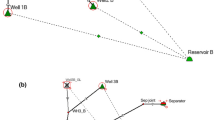Abstract
Thermal Enhanced Oil Recovery (EOR) is one of the main contributors to EOR worldwide production. Steam huff and puff injection, one of its methods, is a technique in which steam is injected in a cyclical manner alternating with oil production. Reservoir simulation is considered as the most reliable solution to evaluate the reservoir performance and designing an optimized production scheme. However, it still remains time-consuming and expensive. Applying machine learning to build a predictive proxy model is a suitable solution to deal with the issue. Presently, there have been a limited number of studies covering the topic of proxy model development to estimate production performance for this injection method. This study provides a review of the machine learning implementations for estimating steam huff and puff injection production performance, starting with an introductory explanation about the method, followed by the currently deployed machine learning models along with the challenges and future prospects.
Access this chapter
Tax calculation will be finalised at checkout
Purchases are for personal use only
Similar content being viewed by others
References
Green DW, Willhite GP (1998) Enhanced oil recovery, 1st edn. Society of Petroleum Engineers
McGlade C, Sondak G, Han M (2018) Whatever happened to enhanced oil recovery?. International energy agency (2018). https://www.iea.org/commentaries/whatever-happened-to-enhanced-oil-recovery. Last Accessed 28 Oct 2020
Negash BM, Tufa LD, Ramasamy M et al (2017) System identification based proxy model of a reservoir under water injection. Model Simul Eng 7645470
Zubarev DI (2009) Pros and cons of applying proxy-models as a substitute for full reservoir simulations. In: SPE annual technical conference and exhibition, New Orleans, Lousiana, USA
Taber JJ, Martin FD, Seright RS (1997) EOR screening criteria revisited—part 1: introduction to screening criteria and enhanced recovery field projects. SPE Reserv Eng J 12(3):189–197
Farouq Ali SM (1974) Current status of steam injection as a heavy oil recovery method. JPT 13(1):54–68
Sheng J (2013) Enhanced oil recovery field case studies. Gulf Professional Publishing
Buckles RS (1979) Steam stimulation heavy oil recovery at cold lake, Alberta. In: SPE California regional meeting, 18–20 April, Ventura, California
Beattie CI, Boberg TC, McNab GS (1991) Reservoir stimulation in the cold lake oil sands. SPE Reservoir Eng
De Haan HJ, Van Lookeren J (1969) Early results of the first large-scale steam soak project in the Tia Juana. J Petrol Technol 21
Puig F, Schenk L (1984) Analysis of the performance of the M-6 area of the Tia Juana Field, Venezuela, under primary, steam-soak, and steamdrive conditions. In: Society of petroleum engineers AIME, SPE, vol 1. pp 263–276
Jones J (1977) Cyclic steam reservoir model for viscous oil, pressure depleted, gravity drainage reservoirs. In: SPE California regional meeting California
Liu W-Z (1997) Steam injection technology to produce heavy oils. Petroleum Industry Press Beijing, China
Gael BT, Gross SJ, McNaboe GJ (1995) Development planning and reservoir management in the Duri steam flood. In: SPE western regional meeting, 8–10 March, Bakersfield, California
Pearce JC, Megginson EA (1991) Current status of the duri steamflood project Sumatra, Indonesia. In: SPE International thermal operations symposium, 7–8 February, Bakersfield, California
Bae WS, Masduki A, Permadi AK, Abdurrahman M (2017) EOR in Indonesia: past, present, and future. Int J Oil and Gas Coal Technol 16(3):250
Boberg TC, Lantz RB (1966) Calculation of the production rate of a thermally stimulated well. J Petrol Technol 18(12):1613–1623. Society of Petroleum Engineers
Gontijo JE, Aziz K (1984) A simple analytical model for simulating heavy oil recovery by cyclic steam in pressure-depleted reservoirs. In: SPE annual technical conference and exhibition, 16–19 September, Houston, Texas
Sylvester NB, Chen HL (1988) Improved cyclic steam stimulation model for pressure-depleted reservoirs. Soc Pet Eng AIME, SPE, pp 213–226
Gozde S, Chhina HS, Best DA (1989) Analytical cyclic steam stimulation model for heavy oil reservoirs. In: SPE California regional meeting, 5–7 April, Bakersfield, California
Jaber AK et al (2019) A review of proxy modelling applications in numerical reservoir simulation. Arabian J Geosci. Saudi Society for Geosciences
Ertekin T, Sun Q (2019) Artificial intelligence applications in reservoir engineering: a status check. Energies. MDPI
Arpaci B (2014) Development of an artificial neural network for cyclic steam stimulation method in naturally fractured reservoirs. Master Thesis, The Pennsylvania State University
Sun Q, Ertekin T (2015) The development of artificial-neural-network-based universal proxies to study steam assisted gravity drainage (SAGD) and cyclic steam stimulation (CSS) processes. In: SPE Western regional meeting, 27–30 April, Garden Grove, California, USA
Ersahin A, Ertekin T (2019) Artificial neural network modeling of cyclic steam injection process in naturally fractured reservoirs. SPE Reservoir Evaluation and Engineering. SPE
Alvarado V, Manrique E (2010) Enhanced oil recovery: an update review. Energies
Alvarez J, Han S (2013) Current overview of cyclic steam injection process. J Petroleum Sci Res 2(3)
Author information
Authors and Affiliations
Editor information
Editors and Affiliations
Rights and permissions
Copyright information
© 2022 The Author(s), under exclusive license to Springer Nature Singapore Pte Ltd.
About this paper
Cite this paper
Merdeka, M.G., Ridha, S., Negash, B.M., Ilyas, S.U. (2022). Current Overview of Machine Learning Application for Predicting Steam Huff and Puff Injection Production Performance. In: Ibrahim, R., K. Porkumaran, Kannan, R., Mohd Nor, N., S. Prabakar (eds) International Conference on Artificial Intelligence for Smart Community. Lecture Notes in Electrical Engineering, vol 758. Springer, Singapore. https://doi.org/10.1007/978-981-16-2183-3_57
Download citation
DOI: https://doi.org/10.1007/978-981-16-2183-3_57
Published:
Publisher Name: Springer, Singapore
Print ISBN: 978-981-16-2182-6
Online ISBN: 978-981-16-2183-3
eBook Packages: Computer ScienceComputer Science (R0)




